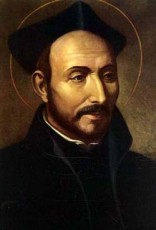Catholic Blesseds, Saints, Solemnities & Holy Days

Saint Ignatius of Loyola
Feast Day: July 31
Patronage: Soldiers, Educators, Education, Spiritual Retreats
St. Ignatius was born in 1491, and was a Spanish Knight from a noble family. Ignatius was seriously wounded in battle in 1521 and underwent a spiritual conversion while in recovery. This spiritual conversion inspired him to abandon his military life for one of service to God, hanging his military uniform in front of a Blessed Mother Statue. He experienced a vision of the Virgin Mary and the infant Jesus while at the Shrine of “Our Lady of Montserrat”. After this vision, he went to Maresa, where he began praying for seven hours a day, often in a nearby cave while formulating the fundamentals of the faith. In 1523 Loyola reached the Holy Land with plans to settle there, but was sent back to Europe by the Franciscans.
Ignatius studied theology and Latin in Spain and Paris, arriving in France during a period of anti-Protestant turmoil. He and few followers bound themselves by vows of poverty, chastity, and obedience – there were 6 in the beginning, with one of them being St. Francis Xavier. They formed the Society of Jesus (Jesuits) approved by Pope Paul II, in 1540, as well as his Spiritual Exercises being approved in 1548. He composed the Constitutions of the Society as well. Loyola’s devotion to the Catholic Church was characterized by unquestioning obedience to the Catholic Church’s authority and Hierarchy. St. Ignatius founded the Roman College, and used that as a model for all other Colleges of the Society.
St. Ignatius was a true mystic. Centering his life on the foundations of Christianity-the Trinity, Christ, and the Holy Eucharist. His spirituality is expressed in the Jesuit motto, “For the Greater Glory of God”. His Society was guided by true love of the Church, and unconditional obedience to the Holy Father, so much so – all professed took a fourth vow, to go wherever the Pope should send them for the salvation of souls. He died in 1556, beatified in 1609, and canonized in 1622.





